Khiva and Kokand. The armed forces of the Turkestan khanate
Kokand Khanate and his army
In the 16th century, the territory of the Fergana Valley formally remained under the rule of Bukhara, which constantly competed with the Khiva Khanate. With the weakening of the power of the emir of Bukhara, caused by the protracted confrontation with Khiva, the biy of Ahsa Ilik-Sultan intensified in Fergana. He established control over the Fergana Valley and became in fact an independent ruler of the region. The descendants of Ilik-Sultan continued to rule Fergana. In the place of the small villages of Kalvak, Aktepe, Eski Kurgan and Hokand, the city of Kokand arose. In 1709, the city of Shakhrukh-II II united the Fergana Valley under its authority and became the ruler of an independent state - the Kokand Khanate. As in the Bukhara and Khiva states, Uzbek tribes were in power in Kokand, while the Uzbeks made up the bulk of the population of the khanate. In addition to Uzbeks, Tajiks, Kyrgyz, Kazakhs, and Uighurs lived in the Kokand Khanate. As for the armed forces of the Kokand Khanate, before the beginning of the 19th century there was no regular army in the state. In the event of the outbreak of hostilities, the Kokand Khan gathered tribal militias, which were a “disorderly horde”, devoid of strict military discipline and a formal hierarchy. Such a militia was an extremely unreliable army, not only because of the lack of advanced military training and weak weapons, but also due to the fact that the moods of the tribes were determined by the tribes, who did not always agree with the position of the khan.
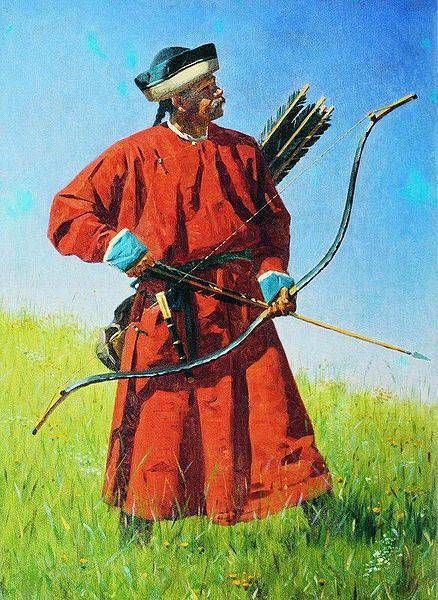
Alimkhan ((1774 - 1809)), who ruled the Kokand Khanate in 1798-1809, acted as a reformer of the Kokand army. Young Alimkhan, who was descended from the Ming Uzbek dynasty that ruled in Kokand, began decisive transformations in the state. In particular, Alimkhan annexed to the Kokand Khanate the valleys of the Chirchik and Akhangaran rivers, all of Tashkent’s patronage, as well as the cities of Chimkent, Turkestan and Sairam. But in the context of this article, attention should be paid to another important merit of Alimkhan for the Kokand khanate - the creation of regular armed forces. If earlier Kokand, like Bukhara and Khiva, did not have a regular army, Alimkhan, seeking to limit the power of the tribal beks and increase the fighting capacity of the Kokand army, set about creating a regular army for which mountain Tajiks were recruited. Alimkhan believed that the Tajik sarbaz would be more reliable warriors than the tribal militia of the Uzbek tribes, strongly dependent on the positions of their beks. Relying on the Tajik Sarbaz, Alimkhan and carried out his conquests, going into history Kokand Khanate as one of its most significant rulers. In addition to the Tajik foot sarbaz, the Kokand Khan was subordinate to the equestrian Kyrgyz and Uzbek tribal militias, as well as the police (kurbashi) subordinate to the Beks and Khakims - the rulers of the administrative-territorial units of the Khanate. Tashkent was run by the Beclar-Begi - “Bek Bekov”, to which the police officers - Kurbashi and Mukhtasiby - guards supervised the observance of Sharia law. The armament of the Kokand army was weak. Suffice it to say that in 1865, during the capture of Tashkent, two thousand sarbazov were dressed in armor and armor. Most of the Kokand sarbazov and equestrian tribal militias were armed with cold weapons, first of all, with sabers, pikes and spears, bows with arrows. Firearms were obsolete and represented mainly by wick guns.
Conquest of the Kokand Khanate
During the Tashkent campaign, Alimkhan was killed by people of his younger brother Umar-Khan (1787-1822). Established on the throne of Kokand, Umar Khan gained fame as a patron of culture and science. During the reign of Umar Khan, the Kokand Khanate maintained diplomatic relations with the Russian Empire, the Emirate of Bukhara, the Khiva Khanate, and the Ottoman Empire. In the following decades, the situation in the Kokand Khanate was characterized by a constant internecine struggle for power. The main warring parties were sedentary Sarts and nomadic Kipchaks. Each side, having won a temporary victory, brutally cracked down on the defeated. Naturally, the socio-economic and political situation of the Kokand Khanate suffered greatly from civil strife. The situation was aggravated by constant conflicts with the Russian Empire. As is known, the Kokand Khanate claimed power in the Kazakh steppes, but the Kyrgyz and Kazakh tribes preferred to become citizens of the Russian Empire, which contributed to further aggravation of bilateral relations. In the middle of the 19th century, at the request of the Kazakh and Kyrgyz tribes who had passed into Russian citizenship, the Russian Empire began military campaigns on the territory of the Kokand Khanate - in order to weaken Kokand positions and destroy fortresses that threatened the Kazakh steppes. By 1865, Russian troops seized Tashkent, after which the Turkestan region was formed, with the Russian military governor at the head.
In 1868, the Kokand Khan Khudoyar was forced to sign a commercial contract offered to him by Adjutant-General Kaufman, which gave him the right to free residence and passage of both Russians on the territory of the Kokand Khanate, and Kokands - on the territory of the Russian Empire. The contract actually established the dependence of the Kokand Khanate on the Russian Empire, which could not please the Kokand elite. Meanwhile, the socio-economic situation in the Kokand Khanate itself has seriously deteriorated. When Khudoyar Khan was introduced, new taxes were imposed on residents, and so suffered from the khan oppression. Among the new taxes were even taxes on reed, on the steppe spines, on leeches. Khan did not even seek to maintain his own army — the sarbaz were not paid a salary, which prompted them to look for food on their own, that is, in fact engage in looting and robbery attacks. As historians note, “Khudoyar Khan not only did not temper cruelty in management, but, on the contrary, used purely Oriental cunning, his new position as a friendly Russian neighbor for his despotic goals. The powerful patronage of the Russians served him as a guard against Bukhara’s constant claims, on the one hand, and on the other, as one of the means of intimidating his recalcitrant subjects, especially the Kyrgyz ”(Incidents in the Kokand Khanate // Turkestan collection. T. 148).
- Kokand sarbazy in the courtyard of the Khan's palace
The policy of Khudoyar turned against even his closest comrades-in-chief, led by Crown Prince Nasreddin, against the Khan. On the side of the rebels, the four-thousand-strong army moved, sent by the khan to pacify the Kyrgyz tribes. 22 July 1874. The rebels besieged Kokand, and Khan Khudoyar, accompanied by Russian envoys, including General Mikhail Skobelev, fled to the territory of the Russian Empire - to Tashkent, which at that time was already under Russian control. The Khan's throne in Kokand was taken by Nasreddin, who condoned the anti-Russian policy of the Kokand aristocracy and clergy. In the Kokand khanate, real anti-Russian hysteria began, accompanied by pogroms of postal stations. 8 August 1875, the 10 thousandth Kokand army approached Khojent who was part of the Russian Empire. Gradually, the number of Kokand residents gathered at Khujand increased to 50 thousands. Due to the fact that the Khan declared Gazavat - “holy war”, crowds of fanatically-minded residents of the Kokand Khanate, armed with anything, rushed to Khujand. On August 22, there was a general battle in which the Kokands lost a thousand and a half people dead, while only six soldiers died on the Russian side. The fifty thousandth Kokand army, commanded by Abdurrahman Avtobachi, fled. 26 August Russian troops under the command of General Kaufman approached Kokand. Realizing the hopelessness of his position, Khan Nasreddin went to meet the Russian troops with the request for surrender. On September 23, General Kaufman and Khan Nasreddin signed a peace treaty, in accordance with which the Kokand Khanate refused to independent foreign policy and conclude treaties with any other state other than the Russian Empire.
However, the leader of the anti-Russian resistance, Abdurrahman Avtobachi, did not recognize the agreement concluded by the khan and continued fighting. His troops retreated to Andijan, and on September 25, the rebels proclaimed a new khan of the Kyrgyz, Pulat-bek, whose candidacy was supported by the all-powerful Avtobachi. Meanwhile, in January 1876, a decision was made to liquidate the Kokand Khanate and to annex it to Russia. The resistance of the rebels led by Avtobachi and Pulat-bek was gradually crushed. Soon Abdurrahman Avtobachi was arrested, who was sent to settle in Russia. As for Pulat-bek, known for his extreme cruelty to Russian prisoners of war, he was executed on the main square of the city of Marghelan. The Kokand Khanate ceased to exist and became part of the Turkestan Governor-General as the Ferghana region. Naturally, after the conquest of the Kokand Khanate and its incorporation into the Russian Empire, the armed forces of the Khanate also ceased to exist. Part of the Sarbaz returned to civilian life, some continued to engage in the service of guarding caravans, there were also those who went into criminal activity, organizing looting and robbery in the vast Fergana Valley.
Khiva Khanate - the heir of Khorezm
After the Russian conquest of Central Asia, the statehood of only the Emirate of Bukhara and the Khiva Khanate, which became the protectorate of the Russian Empire, was formally preserved. In fact, the Khiva khanate existed only in the lexicon of historians, political and military leaders of the Russian Empire. Throughout its history, it was officially called the Khorezm state or simply Khorezm. And the capital was Khiva - and that is why the state, created in 1512, by the nomadic Uzbek tribes, was called by the local historians the Khiva Khanate. In 1511, the Uzbek tribes, under the leadership of the sultans of Ilbas and Balbars - Chingizids, descendants of Arab-Shah ibn Pilad, captured Khorezm. Thus, a new khanate appeared under the authority of the Arabshakhid dynasty, which, through Arab Shah, rose to Shiban, the fifth son of Jochi, the eldest son of Genghis Khan. At first, the capital of the Khanate remained Urgench, but during the reign of Arab Muhammad Khan (1603 — 1622), Khiva became the capital, retaining the status of the main city of the Khanate for three centuries - until its end. The population of the Khanate was divided into nomadic and sedentary. The dominant role was played by the nomadic Uzbek tribes, however, some Uzbeks gradually settled and merged with the ancient sedentary population of the Khorezm oases. By the middle of the XVIII century, the Arabshakhid dynasty gradually lost its power. The real power was in the hands of the Atalyks and the Inaks (tribal leaders) of the Uzbek nomadic tribes. For power in the Khiva Khanate competed two major Uzbek tribes - mangytes and kungrats. In 1740, the territory of Khorezm was conquered by the Iranian Nadir Shah, but in 1747, after his death, the power of Iran over Khorezm ended. As a result of the internecine struggle, the leaders of the Kungrats tribe prevailed. In 1770, the leader of the Kungrats, Muhammad Amin-biy, was able to defeat the militant Turkmen Yomuds, after which he seized power and laid the foundation of the Kungratov dynasty, which for the next one and a half centuries ruled the Khiva khanate. However, the formal rule of Chingizids, who were invited from the Kazakh steppes, remained at first in Khorezm. Only in 1804 was the grandson of Muhammad Amin-biya Eltuzar proclaimed himself Khan and finally removed Chingizids from the management of the khanate.
Khiva was an even more underdeveloped state than its southern neighbor, the Emirate of Bukhara. This was due to a smaller percentage of the sedentary population and a significant number of nomads - Uzbek, Karakalpak, Kazakh, Turkmen tribes. Initially, the population of the Khiva Khanate consisted of three main groups - the 1) nomadic Uzbek tribes who settled in Khorezm from Desht-i-Kypchak; 2) Turkmen tribes; 3) descendants of the ancient sedentary Iranian-speaking population of Khorezm, who by the time of the described events took on Turkic dialects. Later, as a result of territorial expansion, the lands of the Karakalpak tribes, as well as a number of Kazakh lands, were annexed to the Khiva khanate. The policy of subjugating the Karakalpaks, Turkmen and Kazakhs was carried out by Muhammad Rahim-khan I, who ruled from 1806 to 1825, and then his heirs. Under Eltuzar and Muhammad Rahim-Khan I, the foundations of a centralized Khiva statehood were laid. Thanks to the construction of irrigation facilities, a gradual settlement of Uzbeks took place, new cities and villages were built. However, the general standard of living of the population remained extremely low. In the Khiva Khanate, food was more expensive than in the neighboring Emirate of Bukhara, and the population had less money. In winter, Turkmen people, who bought bread in exchange for meat, roamed around Khiva. Local peasants - Sarts grew wheat, barley, and horticultural crops. At the same time, the level of development of urban culture, including crafts, also remained unsatisfactory.
Unlike the cities of the Bukhara Emirate, Khiva and the three other cities of the Khanate were of no interest to the Iranian, Afghan and Indian merchants, since, due to the poverty of the population, no goods were sold here, there were no products of their own making that could interest foreigners. The only truly developed "business" in the Khiva Khanate was the slave trade - here were the largest slave markets in Central Asia. Periodically, Turkmen, who were vassals of Khiva Khan, made predatory raids into the Iranian province of Khorasan, where they captured prisoners who were subsequently enslaved and used in the economy of Khiva khanate. The raids on slaves were caused by a serious shortage of human resources in the sparsely populated Khorezm lands, but for neighboring states such activities of the Khiva khanate posed a serious threat. Khiva residents also caused serious damage to the caravan trade in the region, which was one of the main reasons for the start of the Khiva campaigns of the Russian troops.
Khiva army
Unlike the Bukhara Emirate, the history and structure of the armed forces of the Khiva Khanate are very poorly studied. Nevertheless, according to separate memoirs of contemporaries, it is possible to recreate some details of the organization of the defense system of the Khiva khanate. The geographical position of Khiva, constant participation in wars and conflicts with its neighbors, the low level of economic development - all of this together caused the militancy of the Khiva khanate. The military power of the Khanate consisted of the forces of the nomadic tribes - Uzbeks and Turkmen. At the same time, all authors - contemporaries recognized the great militancy and inclination to participate in the hostilities of the Turkmen population of the Khiva khanate. Turkmen played a crucial role in organizing slave raids on Persian territory. The Khiva Turkmen, penetrating into the territory of Persia, came into contact with representatives of the local Turkmen tribes, who acted as gunners and pointed out the least protected villages, in which it was possible to live well with both things and products, and "living goods". The hijacked Persians were then sold in the Khiva slave markets. At the same time, the Khiva Khan received one fifth of the slaves from each campaign. Turkmen tribes were the main and most combat-ready part of the Khiva army.
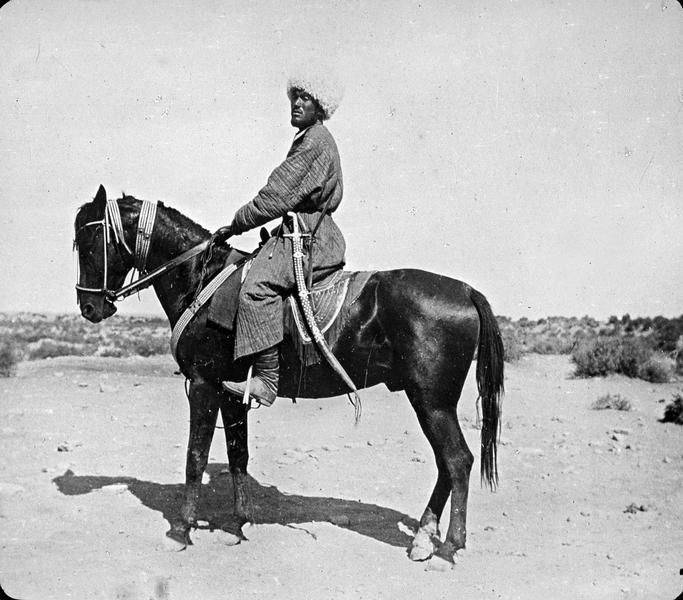
According to historians, the army in the modern sense of the word was absent in the Khiva Khanate: “Khiva people do not have a permanent army, but if necessary, the Uzbeks and Turkmen, who make up their own militant population, are taken as weapons by the order of the Khan. Of course, there is no discipline in such a conciliar army, and as a result there is no order and subordination ... There are no lists of soldiers ”(quoted in: History of Central Asia. Collection of historical works. M., 2003, S. 55). Thus, in the event of war, the Khiva Khan mobilized the tribal militias of the Uzbek and Turkmen tribes. The Uzbeks and Turkmen performed on their own horses and with their own weapons. There was practically no military organization and discipline in the horse hordes of Khiva. The most skillful and courageous warriors made up the personal protection of the Khiva Khan, and the commanders of the forward detachments who raided enemy territory were also selected from them. The leaders of such units were called Sardars, but had no authority over their subordinates.
The total number of the army gathered by the Khiva Khan did not exceed twelve thousand people. However, in the event of a serious threat to the khanate, the khan could mobilize the Karakalpak and Sart populations, which allowed an increase in the number of troops by about two or three times. However, the numerical increase in troops as a result of the mobilization of sarts and Karakalpaks did not mean an increase in its combat capability — after all, the mobilized people had no special military training; Therefore, from the mobilized Sarts and the Karakalpaks to the Khiva Khan there were only problems, which made him gather militia from civilians only in the most extreme cases. Since the Khiva army actually was a tribal militia, the issues of its material support were completely on the soldiers themselves.
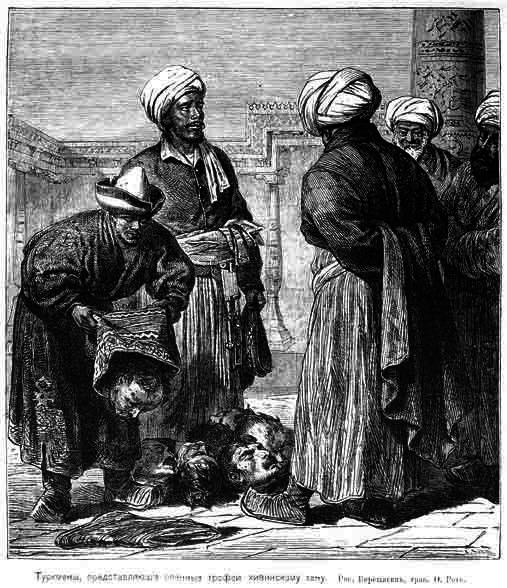
Usually the Khiva warrior took with him on a campaign loaded with food and utensils of a camel, the poor Khivans were limited to one camel for two. Accordingly, in the march of the Khiva's cavalry, a huge wagon train consisting of loaded camels and their drivers, as a rule slaves, followed. Naturally, the presence of a huge convoy affected the speed of movement of the Khiva army. In addition to the extremely slow movement, another feature of the Khiva army was the short duration of the marches. Khiva army could not stand more than one and a half months hike. After forty days, the Khiva army began to disperse. At the same time, taking into account that no account was taken of the personnel and, accordingly, the payment of a salary, the Khiva army was not kept; its soldiers quietly dispersed separately and in groups to their homes and did not bear any disciplinary responsibility for it. Khiva campaigns usually did not continue for more than forty days. However, this period was also enough for the Uzbek and Turkmen soldiers to get hold of good during the robberies of the population of the territories they pass through.
Structure and armament of Khiva troops
As for the internal structure of the Khiva army, the complete absence of infantry should be noted. The Khiva army always consisted of the same cavalry - the cavalry militias of the Uzbek and Turkmen tribes. This nuance deprived the Khiva's army of the ability to conduct military operations by methods other than a clash in the open field. Only sometimes dismounted cavalry could ambush, but the Khivans were unable to storm the enemy fortifications. However, in horse battles, the Turkmen cavalry of the Khiva Khans showed themselves very effectively. Turkmen riders, as the authors of the time noted, moved very quickly, being excellent riders and arrows. In addition to the Turkmen and Uzbek cavalry, the Khiva khanate also had its own artillery, although very few. In the Khan's capital Khiva there were seven artillery pieces, which, according to the descriptions of their contemporaries, were in poor condition. Back in the reign of Muhammad Rahim Khan, experiments on the ebb of their own artillery began in Khiva. However, these experiments were unsuccessful, because the guns were cast with vents and, when tested, the gun was often torn. Then the artillery guns were cast on the advice of Russian prisoners and the gunsmith, issued by the Khiva Khan from Istanbul. As for the production of gunpowder, it was made in workshops owned by Sarta. Saltpeter and sulfur were mined in the Khiva territory, which made the gunpowder cheap. At the same time, the quality of the powder was very low due to non-compliance with the proportions of its constituent substances. The service of artillery guns during the campaigns of the khans trusted exclusively to Russian prisoners, recognizing the technical literacy of the latter and their greater suitability for artillery service in comparison with the Uzbeks.
Khiva cavalry was armed with weapons and firearms. Among the weapons should be noted saber - as a rule, Khorasan production; spears and pikes; bows with arrows. Some riders even in the first half of the XIX century, dressed in damask shells and helmets, hoping to defend themselves against enemy sabers and rush. As for firearms, before the Russian conquest of Central Asia, the Khiva army was armed mainly with wick guns. Outdated firearms had a negative effect on the firepower of the Khiva army, since it was impossible to shoot from the horse from most of the guns - only lying down, from the ground. As N.N. Ants-Karsky, “because they are used only in ambushes; their butts are quite long; a wick is wound on them, whose end is grasped by iron tweezers attached to the butt; these tweezers are applied to the shelf by means of an iron rod held by the shooter to the right hand; by the end of the trunk, prisoshki in the form of two large horns were attached to the bed. “They like to decorate the trunks of their rifles with a silver notch” (quoted in: Journey to Turkmenistan and Khiva in 1819 and 1820, Guards General Staff captain Nikolai Muravyov, sent to these countries for negotiations. - M.: Augustus Seeds, 1822 ).
Three "Khiva campaign" and the conquest of Khiva
Russia three times tried to establish its position in the region controlled by the Khiva Khanate. The first "Khiva campaign", also known as the expedition of Prince Alexander Bekovich-Cherkassky, took place in 1717 year. 2 June 1714 of the year Peter I issues a decree “On sending a Transfiguration Regiment, captain Lieutenant Prince. Alex Bekovich-Cherkassky to find the mouths of the Darya River ... ". Bekovich-Cherkassky was tasked to: investigate the former course of the Amu Darya and turn it into the old course; on the way to Khiva and on the mouth of the Amudarya to build fortresses; incite Khiva Khan to Russian citizenship; to incline the Bukhara Khan to citizenship; send under the guise of a merchant lieutenant Kozhin to India, and another officer - to Erket, in order to detect gold deposits. For these purposes, Bekovich-Cherkassky was allocated a detachment of 4 thousands of people, half of whom were Grebensky and Yaik Cossacks. In the area of the mouth of the Amu Darya, a detachment met the Khiva army, several times superior to the Bekovich-Cherkassky expedition in number. But, given the superiority in weapons, the Russian detachment managed to inflict serious damage on the Khivaites, after which Shergazi Khan invited Bekovich-Cherkassky to Khiva. The prince arrived there accompanied by an 500 man from his unit. Khan managed to persuade Bekovich-Cherkassky to place Russian troops in five cities of Khiva, which required the division of the detachment into five parts. Bekovich-Cherkassky succumbed to the trick, after which all the troops were destroyed by the superior forces of Khiva. The decisive role in the destruction of the Russian troops was played by the soldiers of the Turkmen Yomud tribe who were in the service of the Khiva Khan. Bekovich-Cherkassky himself was slaughtered during a celebratory feast in the city of Porsu, and the Khiva Khan sent his head as a gift to the Emir of Bukhara. Most Russians and Cossacks fell into Khiva captivity and were enslaved. However, in 1740, Khiva took the Persian Nadir Shah, who freed the remaining Russian prisoners by that time, supplied them with money and horses, and released them to Russia.
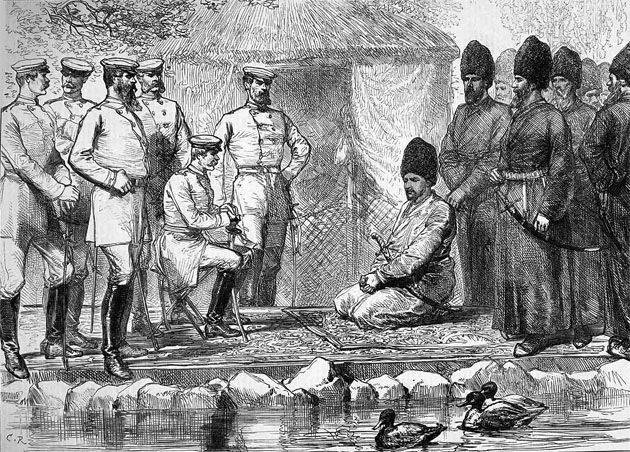
The second attempt of approval in Central Asia was undertaken more than a century after the Bekovich-Cherkassky campaign, which had failed and ended in tragedy. This time, the main reason for the Khiva campaign was the desire to protect the southern borders of the Russian Empire from the constant attacks of the Khiva people and to ensure the safety of Russia's trade communication with Bukhara (the Khiva detachments regularly attacked caravans passing through the Khiva khanate). In 1839, on the initiative of the Orenburg Governor-General Vasily Alekseevich Perovsky, an expeditionary force of Russian troops was sent to the Khiva khanate. Adjunct General Perovsky himself commanded them. The number of corps was 6651 people, representing the Ural and Orenburg Cossack troops, the Bashkir-Mescheryak army, the 1-th Orenburg regiment of the Russian army and artillery units. However, this campaign did not bring victory to the Russian Empire over the Khiva Khanate. The troops were forced to return to Orenburg, and the losses amounted to 1054 man, most of whom died from disease. Another 604 man on his return from a hike hit the hospital, many of them died from diseases. 600 people were captured by the Khivans and returned only in October 1840. However, the campaign still had a positive consequence - in 1840, Khiva Kuli Khan issued a decree banning the capture of Russians and even forbade buying Russian captives from other steppe peoples. Thus, Khiva Khan intended to normalize relations with the powerful northern neighbor.
Repeated Khiva campaign was undertaken only in 1873 year. By this time, the Russian Empire had subdued the Emirate of Bukhara and the Kokand Khanate, after which the Khiva Khanate remained the only independent state in Central Asia, surrounded on all sides by Russian territories and the lands of the Bukhara Emirate, which had adopted the protectorate of the Russian Empire. Naturally, the conquest of the Khiva Khanate remained a matter of time. At the end of February - the beginning of March, 1873 of the Russian troops with a total of 12-13 thousand troops marched on Khiva. The corps command was entrusted to the Turkestan Governor-General Konstantin Petrovich Kaufman. On May 29, Russian troops entered Khiva, and the Khiva Khan capitulated. Thus ended the history of the political independence of the Khiva khanate. Between Russia and the Khiva Khanate a Gendemian peace treaty was concluded. Khiva Khanate recognized the protectorate of the Russian Empire. Like the emirate of Bukhara, the Khiva khanate continued its existence while preserving the former institutions of power. Muhammad Rahim Khan II Kungrat, who recognized the power of the Russian emperor, received the rank of lieutenant-general of the Russian army in 1896, and in 1904 the title of general from cavalry. He made a great contribution to the development of culture in Khiva — it was under Muhammad Rahim Khan II that printing began in Khiva Khanate, the Madrasah Muhammad Rahim Khan II was built, and the famous poet and writer Agakhi wrote his History of Khorezm. In 1910, after the death of Muhammad Rahim Khan II, his 39-year-old son Seyid Bogatur Asfandiyar-Khan (1871-1918, pictured) entered the Khiva's throne.
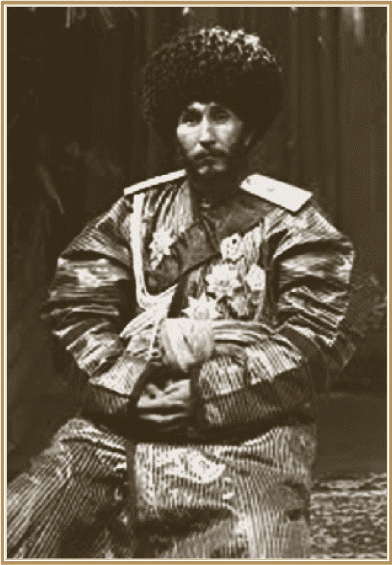 He was immediately given the rank of Major General of the Imperial Suite, Nicholas II awarded the Khan with the Orders of St. Stanislav and St. Anne. Khiva Khan was assigned to the Orenburg Cossack army (the Emir of Bukhara, in turn, was attributed to the Cossack Terek army). Nevertheless, despite the fact that some representatives of the Khiva nobility were considered officers of the Russian imperial army, the situation with the organization of the armed forces in the Khanate was much worse than in the neighboring Emirate of Bukhara. Unlike the Bukhara Emirate, a regular army was never created in Khiva. This was due, among other things, to the fact that the nomadic tribes that formed the basis of the Khiva army were extremely alien to military service and permanent military service. Turkmen horsemen, distinguished by their great personal courage and individual skills of excellent riders and shooters, were not adapted for everyday military service. It was impossible to create regular military units from them. In this regard, the sedentary population of the neighboring Emirate of Bukhara was a much more convenient material for the construction of armed forces.
He was immediately given the rank of Major General of the Imperial Suite, Nicholas II awarded the Khan with the Orders of St. Stanislav and St. Anne. Khiva Khan was assigned to the Orenburg Cossack army (the Emir of Bukhara, in turn, was attributed to the Cossack Terek army). Nevertheless, despite the fact that some representatives of the Khiva nobility were considered officers of the Russian imperial army, the situation with the organization of the armed forces in the Khanate was much worse than in the neighboring Emirate of Bukhara. Unlike the Bukhara Emirate, a regular army was never created in Khiva. This was due, among other things, to the fact that the nomadic tribes that formed the basis of the Khiva army were extremely alien to military service and permanent military service. Turkmen horsemen, distinguished by their great personal courage and individual skills of excellent riders and shooters, were not adapted for everyday military service. It was impossible to create regular military units from them. In this regard, the sedentary population of the neighboring Emirate of Bukhara was a much more convenient material for the construction of armed forces. Khiva after the revolution. Red Khorezm.
After the February Revolution in the Russian Empire, tremendous changes also affected Central Asia. It should be noted here that by the year 1917, the Khiva khanate continued to suffer from internecine wars between Turkmen leaders - serdars. One of the main culprits of destabilizing the situation in the Khanate was Junaid Khan, or Mohammed Kurban Serdar (1857-1938) - the son of Baia from the Junaid family of the Turkmen Yomud tribe. Initially, Mohammed-Kurban served as a miraba - water controller. Then, in 1912, Mohammed-Kurban led a detachment of Turkmen horsemen, who were looting caravans that followed through the Karakum sands. Then he received the Turkmen military title "Serdar". To calm the Yomuds and stop the looting of caravans, Khan Asfandiyar launched a punitive campaign against the Turkmen. In retaliation, Mohammed-Kurban Serdar organized a series of attacks on the Uzbek kishlaks of the Khiva khanate. After Asfandiyar-Khan, in the 1916 year, with the help of Russian troops, managed to suppress the resistance of the Yomuds, Mohammed-Kurban Serdar disappeared into the territory of Afghanistan. He reappeared in the Khiva Khanate after the 1917 revolution of the year, and soon entered the service of his former enemy Asfandiyar Khan. A squad of 1600 Turkmen horsemen, subordinate to Junaid Khan, became the basis of the Khiva army, and Junaid Khan himself was appointed commander of the Khiva army.
Gradually, Turkmen serdar acquired such significant positions at the Khiva court that in October 1918 decided to overthrow the Khiva khan. The son of Junaid Khan, Eshi Khan, organized the assassination of Asfandiyar Khan, after which Khan’s young brother Said Abdulla Tyure ascended to the throne in Khiva. In fact, the power in the Khiva Khanate was in the hands of Serdar Junaid Khan (in the photo).
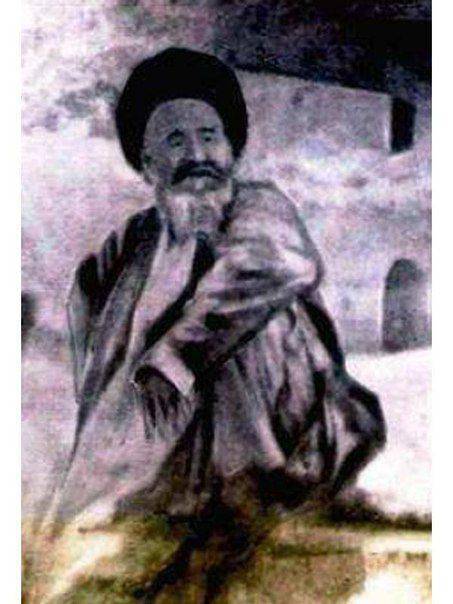 Meanwhile, in 1918, the Khorezm Communist Party was created, which was not distinguished by its multiplicity, but maintained close ties with Soviet Russia. With the support of the RSFSR, in November 1919, the uprising began in the Khiva Khanate. However, initially the forces of the rebels were not enough to overthrow Junaid Khan, so Soviet Russia sent troops to help the Khiva rebels.
Meanwhile, in 1918, the Khorezm Communist Party was created, which was not distinguished by its multiplicity, but maintained close ties with Soviet Russia. With the support of the RSFSR, in November 1919, the uprising began in the Khiva Khanate. However, initially the forces of the rebels were not enough to overthrow Junaid Khan, so Soviet Russia sent troops to help the Khiva rebels. By the beginning of February 1920, the Turkmen detachments of Junaid Khan suffered a complete defeat. 2 February 1920 Khiva’s Said Abdulla Khan abdicated the throne, and 26 April 1920 was proclaimed the Khorezm People’s Soviet Republic as part of the RSFSR. At the end of April, 1920 was created by the Red Army of the Khorezm People's Soviet Republic, subordinate to the People's Naziat for military affairs. Initially, the Khorezm Red Army was staffed by recruiting volunteers for military service, and in September 1921 was introduced general military duty. The number of Red Army HNSR was about 5 thousands of soldiers and commanders. By the summer of 1923, the KhNSR Red Army included: 1 Cavalry Regiment, 1 Separate Cavalry Division, 1 Infantry Regiment. The units of the Red Army of KhNSR helped the Red Army units in the armed struggle against the Turkestan Basmachi movement. October 30 1923, in accordance with the decision of the 4 of the All-Khorezm kurultai Council, the Khorezm People's Soviet Republic was renamed the Khorezm Socialist Soviet Republic. From September 29 to October 2, the 1924 was held on the 5 of the All-Korean Council of Soviets, where it was decided to self-destruct the HSSR. This decision was caused by the need for national-territorial delimitation in Central Asia. Since the Uzbek and Turkmen population of the HSSR competed for dominance in the republic, it was decided to divide the territory of the Khorezm Soviet Socialist Republic between the Uzbek Soviet Socialist Republic and the Turkmen Soviet Socialist Republic. The territory inhabited by the Karakalpaks formed the Karakalpak Autonomous Region, originally part of the RSFSR, and then attached to the Uzbek SSR. Residents of the former Khorezm Soviet Socialist Republic on a general basis began to serve in the ranks of the Red Army. As for the remnants of the subordinate Junaid-Khan of the Turkmen detachments, he took part in the Basmachi movement, in the process of liquidation of which, partly surrendered and moved to peaceful life, partly, were eliminated or left for the territory of Afghanistan.
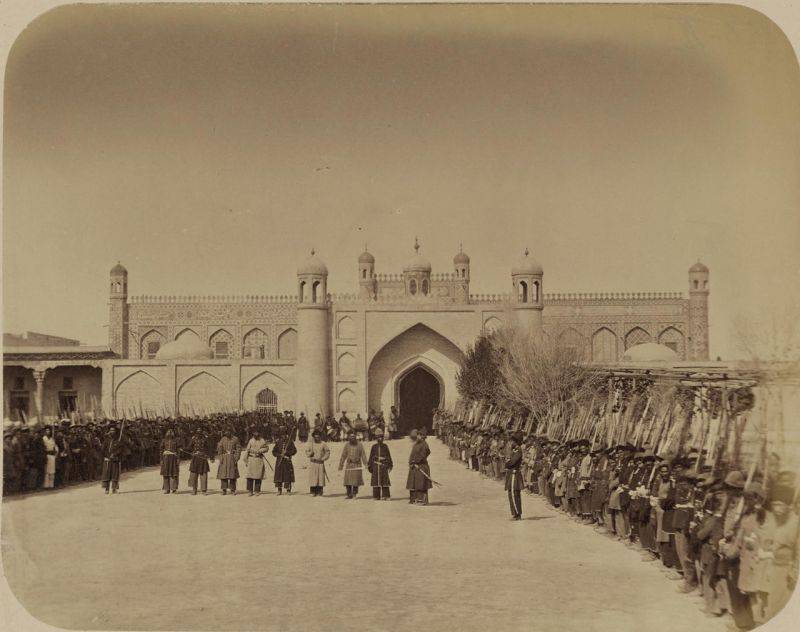
Information